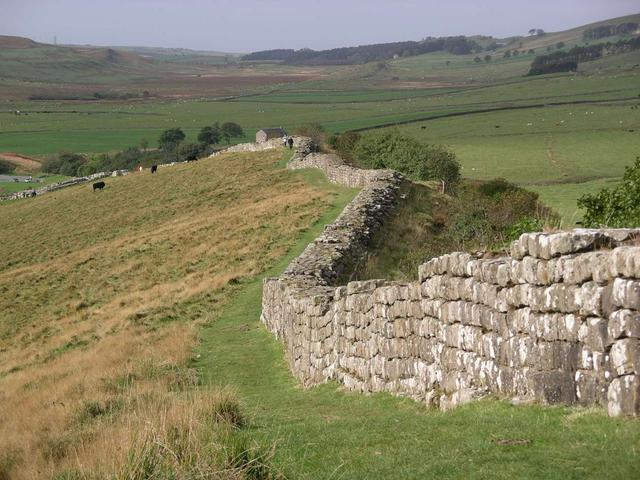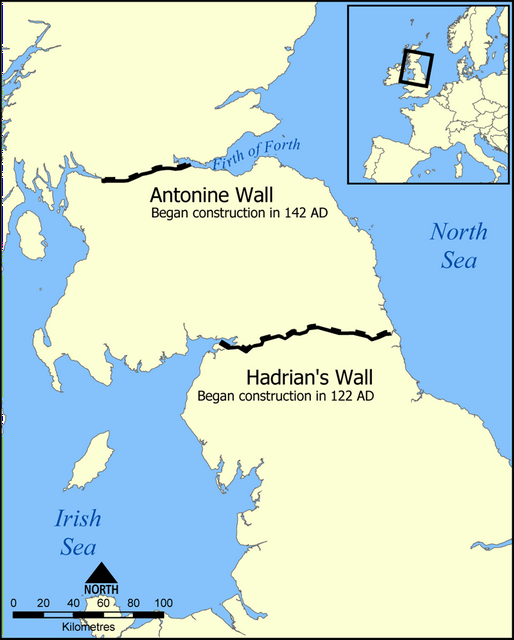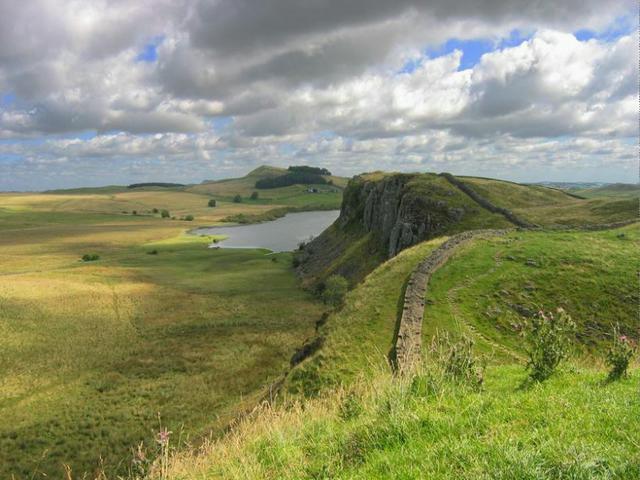Hadrian's Wall was built by the Roman Empire to protect their colony in England from the Pictish tribes in Scotland. It stretches for across the north of England from the Irish Sea to the North Sea in the counties of Cumbria, Northumberland and Tyne and Wear.



Built by Roman soldiers in the 2nd century AD, only stretches of the wall are still visible, but the wealth of archaeological research has resulted in an almost unparalleled cluster of museums and excavations. Hadrian's Wall is inscribed on the UNESCO World Heritage List.
All these towns are near the wall, but the wall is strung out in the countryside.
- Carlisle.
- Haltwhistle.
- Hexham.
- Newcastle upon Tyne.
- Wallsend.
Carlisle.
Haltwhistle.
Hexham.
Newcastle upon Tyne.
Wallsend.
Hadrian's Wall was one of Ancient Rome's fortified borders, which gave the late Roman Empire security against the barbarians at its gates. Constructed and later garrisoned by soldiers drawn from all over the Roman world, the wall preserves an immense amount of military and civilian day-to-day life.
There are several excavated Roman forts. Most of the Roman remains are in the open air: dress for the weather and wear sensible shoes.
- Housesteads, Haydon Bridge, NE47 6NN, +44 1434 344363. open weekends during the winter and every day in summer. The most famous sight on the Wall, Housesteads is the most complete Roman fort in Britain, and one of the best-preserved in Europe. English Heritage are in the process of improving the visitors' centre, replacing the rather small museum. adults £6.20, children £3.70, concessions £5.60.
- Vindolanda. Vindolanda is not quite as complete a ruin, but has a somewhat better museum, and features a reconstructed section of Wall. It is particularly interesting to archaeology. £10 adults, £5.50 children, joint ticket with the Roman Army Museum.
- Chesters, Chollerford, NE46 4EU, +44 1434 681379. A former Roman cavalry fort, Chesters has a fairly extensive - if rather old-fashioned - museum including exhibits excavated at Housesteads and elsewhere. adults £5.40, children £3.20, concessions £4.90.
- Segedunum Roman Fort, Baths & Museum, Buddle Street, Wallsend (Tyne and Wear, +44 191 278-4217. Apr-May: daily 10:00-16:30; June-Aug: daily 10:00-17:00; Sep-Nov 1: daily 10:00-16:00; Nov 2-Mar: daily 10:00-14:30. The remains of the Roman fort at Segedunum, eastern terminus of the Wall. It's a short walk away from the Wallsend Metro stations. In fact many of the signs at the metro station have been translated into Latin, including the aptly named Vomitorium. Adults £5.95, concessions (60+ and students) £3.95. There are numerous smaller forts, milecastles, temples and other buildings. While many are little more than lumps in the ground, many of the better-preserved are now under the care of English Heritage and are listed on the Hadrian's Wall section of their website.
- Mithraeum. One of the few partially preserved temples of the god Mithras in the UK.
The museums are rounded out by the Roman Army Museum.
Look out for military jets training in the skies above Kielder Forest. There is a (relatively) secret RAF base within the forest that serves as an electronic warfare training base.
Housesteads, Haydon Bridge, NE47 6NN, +44 1434 344363. open weekends during the winter and every day in summer. The most famous sight on the Wall, Housesteads is the most complete Roman fort in Britain, and one of the best-preserved in Europe. English Heritage are in the process of improving the visitors' centre, replacing the rather small museum. adults £6.20, children £3.70, concessions £5.60.
Vindolanda. Vindolanda is not quite as complete a ruin, but has a somewhat better museum, and features a reconstructed section of Wall. It is particularly interesting to archaeology. £10 adults, £5.50 children, joint ticket with the Roman Army Museum.
Chesters, Chollerford, NE46 4EU, +44 1434 681379. A former Roman cavalry fort, Chesters has a fairly extensive - if rather old-fashioned - museum including exhibits excavated at Housesteads and elsewhere. adults £5.40, children £3.20, concessions £4.90.
Segedunum Roman Fort, Baths & Museum, Buddle Street, Wallsend (Tyne and Wear, +44 191 278-4217. Apr-May: daily 10:00-16:30; June-Aug: daily 10:00-17:00; Sep-Nov 1: daily 10:00-16:00; Nov 2-Mar: daily 10:00-14:30. The remains of the Roman fort at Segedunum, eastern terminus of the Wall. It's a short walk away from the Wallsend Metro stations. In fact many of the signs at the metro station have been translated into Latin, including the aptly named Vomitorium. Adults £5.95, concessions (60+ and students) £3.95.
Mithraeum. One of the few partially preserved temples of the god Mithras in the UK.
- For a nice day: Breakfast at the Once Brewed YHA hostel, walk to Vindolanda, then loop north to Hadrian's Wall, walk along the wall for a few hours, then walk back to the Twice Brewed Inn for supper and real ale.
- Daytrip from Newcastle upon Tyne: Take bus AD122 from Central Station at 09:30 to Chester Roman Fort (£4.50). Visit the Roman fort and museum (Entrance fee adults £5.00/concession £4.50), then hike on the Hadrian's Wall Trail to Housesteads. Visit the Housesteads Roman Fort and museum (Entrance fee adults £5.00/concession £4.50). Walk to the road (entrance to parking lot) and flag down the bus AD122, which passes here at 17:34 back to Newcastle (£5.50; and the only direct bus to Newcastle).
- Hike the whole of it, from Bowness-on-Solway to Wallsend or vice versa. Book your accommodation couple of months in advance, for the trail is very popular, and if you just knock on the door of a random B&B on your way you'll probably find it fully booked.
Most of the larger attractions on the forts serve refreshments of some description. There are also hotels and public houses in most of the villages dotted around the area.
There is a very slight risk of thieves looking for easy pickings at ill-attended tourist car parks. A locked car is precaution enough. Otherwise, the worst hazard is a sharp rain shower.
- Carlisle
- Gretna
